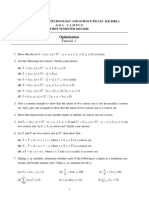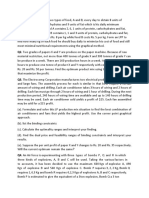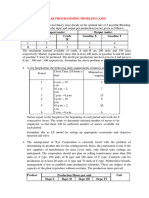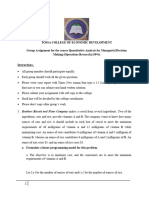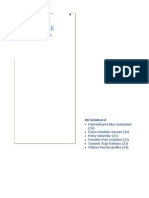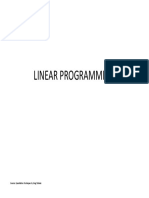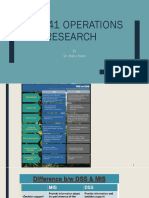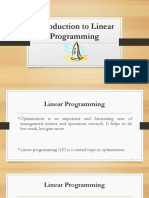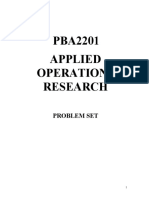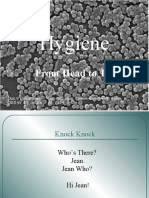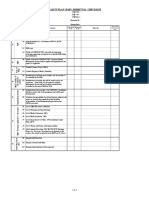1.
A firm produces two types of products A and B and sells them at a price of Rs 2 and Rs
3 respectively. Each product passes through two machines M1 and M2. Product A
requires one minute of processing time on M1 and two minutes on M2. Product B
requires one minute on machine M1 and one minute on M2. The machine M1 is
available for not more than 6 hours while machine M2 is available for 10 hours during
any working day. The firm wishes to determine its daily product mix so as to maximize
revenue.
Formulate the above as a linear programming problem and solve it graphically.
2. A farmer can plant up to 8 acres of land with wheat and barley. He can earn Rs 5,000 for
every acre he plants with wheat and Rs 3,000 for every acre he plants with barley. His
use of a necessary pesticide is limited by federal regulations to 10 gallons for his entire 8
acres. Wheat requires 2 gallons of pesticide for every acre planted and barley requires
just 1 gallon per acre. What is the maximum profit he can make?
3. A small firm has production facilities for producing two different products A and B. Each
of the products requires two different operations- grinding and testing. Product A
requires 15 and 15 minutes to grind and test respectively while product B requires 7.5
and 45 minutes to grind and test respectively. The production run calls for at least 7.5
hours of grinding time and at least 15 hours of testing time. If the manufacturing costs of
the two products are Rs 60 and Rs 90 respectively, how many units of each product
should the firm produce in order to minimize the cost of operation?
4. A dietician wants to design a breakfast menu for certain hospital patients. The menu is to
include two items A and B. Suppose that each ounce of A provides 2 units of vitamin C
and 2 units of iron and each ounce of B provides 1 unit of vitamin C and 2 units of iron.
Suppose the cost of A is Rs 4/ounce and the cost of B is Rs 3/ounce. If the breakfast
menu must provide at least 8 units of vitamin C and 10 units of iron, how many ounces
of each item should be provided in order to meet the iron and vitamin C requirements for
the least cost? What will this breakfast cost?
5. One kind of cake requires 200 g of flour and 25g of fat, and another kind of cake
requires 100 g of flour and 50 g of fat. Find the maximum number of cakes that can be
made from 5 kg of flour and 1 kg of fat assuming that there is no shortage of the other
ingredients, used in making the cakes.
6. A furniture company produces inexpensive tables and chairs. The production process for
each is similar in that both require a certain number of hours of carpentry work and a
certain number of labour hours in the painting department. Each table takes 4 hours of
carpentry and 2 hours in the painting department. Each chair requires 3 hours of
carpentry and 1 hour in the painting department. During the current production period,
240 hours of carpentry time are available and 100 hours in painting is available. Each
table sold yields a profit of Rs 7; each chair produced is sold for a Rs 5 profit. Find the
� best combination of tables and chairs to manufacture in order to reach the maximum
profit.
Source Destination Supply
A B C D E
P 13 6 9 6 10 16
Q 8 2 7 7 9 15
R 2 12 5 8 7 13
Demand 10 15 7 10 2
1. A transportation model has four supplies and five destinations. The following table shows
the cost of shipping one unit from a particular supply to a particular destination.
Solve the transportation problem using Vogel’s Approximation method.
2. A firm can produce 2 types of cloth say A and B. The kinds of wool are required for it are
red and green. One unit length of type A cloth needs 2 metres of red wool and 4 metres of
green wool. One unit length of B type cloth needs 4 metres of red wool and 2 metres of
green wool. The firm has a stock of 24 metres of red wool and 16 metres of green wool. It is
assumed that the income obtained from one unit length of type A cloth is Rs 3 and of B Rs
5.
Formulate the above as a LP problem and solve it graphically.
Source Destination Supply
A B C D E
P 13 6 9 6 10 16
Q 8 2 7 7 9 15
R 2 12 5 8 7 13
Deman 10 15 7 10 2
d 1. A
transportation model has four supplies and five destinations. The following table shows the
cost of shipping one unit from a particular supply to a particular destination.
Solve the transportation problem using Vogel’s Approximation method.
2. A firm can produce 2 types of cloth say A and B. The kinds of wool are required for it are
red and green. One unit length of type A cloth needs 2 metres of red wool and 4 metres of
green wool. One unit length of B type cloth needs 4 metres of red wool and 2 metres of
green wool. The firm has a stock of 24 metres of red wool and 16 metres of green wool. It is
assumed that the income obtained from one unit length of type A cloth is Rs 3 and of B Rs
5.
Formulate the above as a LP problem and solve it graphically.
�Different Parts of the LP Model
1. Decision Variable: Variables which are changeable & going to impact the decision function.
Like the profit function is effected by both sales and price, now which one of these two is
changeable, will be our decision variable.
2. Objective Function: Linear function of the objective, either to Maximize or minimize, like
Maximize Profit, sales, production etc. and Minimize Cost, Loss, energy, consumption, wastage
etc.
3. Constraints: Any kind of limitation or scarcity explained through a function like Limitations of
raw materials, time, funds, equipment's etc. Non-Negative Constraints will also be there which
will remain non-negative all the time.
Formulation of an LP Problem:
1. Recognize the decision variables and assign symbols to them like X, Y, Z & so on). Now
these are the quantities we wish to find out.
2. Express all the constraints in terms of inequalities in relation the decision variable.
3. Formulate the objective function in terms of the decision variables.
4. Add the non-negativity condition/constraints.
A firm produces two types of products P1 and P2 and sells them at a price of Rs 2 and Rs 3
respectively. Each product passes through two machines M1 and M2. P1 requires one minute of
processing time on M1 and two minutes on M2. P2 requires one minute on machine M1 and
one minute on M2. The machine M1 is available for not more than 6 hours while machine M2 is
available for 10 hours during any working day. The firm wishes to determine its daily product
mix so as to maximize revenue.
Formulate the above as a linear programming problem and solve it using the graphical method.











